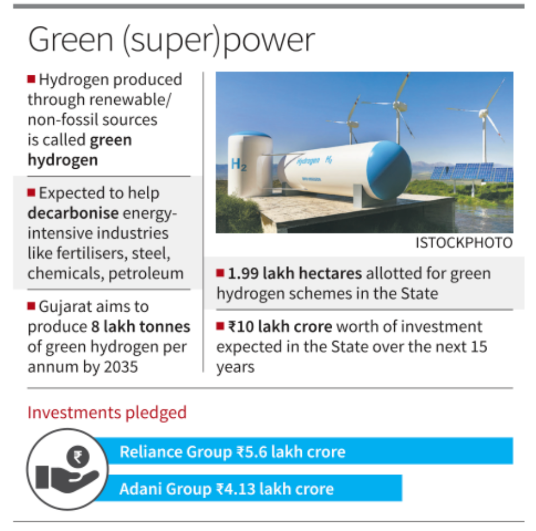Context:
Gujarat has set the ball rolling to become the country’s green hydrogen manufacturing hub and retain its dominance over the industrial sector.
- The State has signed memoranda of understanding (MoUs) with several big corporates.
| Probable Question:
Enumerate the types of hydrogen that can be used as a fuel. Discuss how green hydrogen can support India’s objectives of decarbonization along with the roadblocks faced. |

Image Source: The Hindu
About the news
- Gujarat aims to become a hub for green hydrogen by creating a production capacity of 8 metric tonnes per annum (MTPA) by 2035.
- It plans to give the status of a priority sector by framing a new policy for green hydrogen manufacturing.
- It has alloted of 1.99 lakh hectares in the Kutch Banaskantha border areas for green Hyde schemes.
| Additional Information
National Green Hydrogen Mission: It was approved by the Union Cabinet in 2022, with the intended objectives of:
- Making India a leading producer and supplier of Green Hydrogen in the world
- Creation of export opportunities for Green Hydrogen and its derivatives
- Reduction in dependence on imported fossil fuels and feedstock
- Development of indigenous manufacturing capabilities
- Attracting investment and business opportunities for the industry
- Creating opportunities for employment and economic development
- Supporting R&D projects
Mission Outcomes: The mission outcomes projected by 2030 are:
- Development of green hydrogen production capacity of at least 5 MMT (Million Metric Tonne) per annum with an associated renewable energy capacity addition of about 125 GW in the country
- Over Rs. Eight lakh crore in total investments
- Creation of over Six lakh jobs
- Cumulative reduction in fossil fuel imports over Rs. One lakh crore
- Abatement of nearly 50 MMT of annual greenhouse gas emissions
|
Types of hydrogen based on extraction method:
Depending on the nature of the method of its extraction, hydrogen is categorised into three categories, namely, Grey, Blue and Green.
- Grey Hydrogen: It is produced via coal or lignite gasification (black or brown), or via a process called steam methane reformation (SMR) of natural gas or methane (grey). These tend to be mostly carbon-intensive processes.
- Blue Hydrogen: It is produced via natural gas or coal gasification combined with carbon capture storage (CCS) or carbon capture use (CCU) technologies to reduce carbon emissions.
- Green Hydrogen:
-
- It is produced using electrolysis of water with electricity generated by renewable energy.
- The carbon intensity ultimately depends on the carbon neutrality of the source of electricity (i.e. The more renewable energy there is in the electricity fuel mix, the greener the hydrogen produced).
Benefits of Green Hydrogen:
- Clean source of energy: It can decarbonize a range of sectors including iron and steel, chemicals, and transportation.
- Potential to transform transportation as a direct replacement of fossil fuels.
- Channelizing renewable energy: Renewable energy that cannot be stored or used by the grid can be channelled to produce hydrogen.
- Hydrogen FCEV (Fuel cell electric vehicles) are better in comparison to Battery electric vehicles.
Challenges
- Regulatory Overlap: Ministry of Road Transport and Highways regulates vehicle’s fuel carrier specification, MNRE regulates renewable energy sources and Petroleum and Explosives Safety Organisation regulates explosive substances, storage and fuel station’s specifications.
- Energy-intensive extraction: Hydrogen is not found freely as it exists only combined with other elements and has to be extracted from naturally occurring compounds like water.
- High Cost– The technology used in production and use of hydrogen like carbon capture and storage (CCS) and hydrogen fuel cell technology are at nascent stage and are expensive which in turn increases the cost of production of hydrogen.
- High R&D requirement: The commercial usage of hydrogen as a fuel and in industries requires mammoth investment in R&D.
News Source: The Hindu
![]() 20 May 2023
20 May 2023
